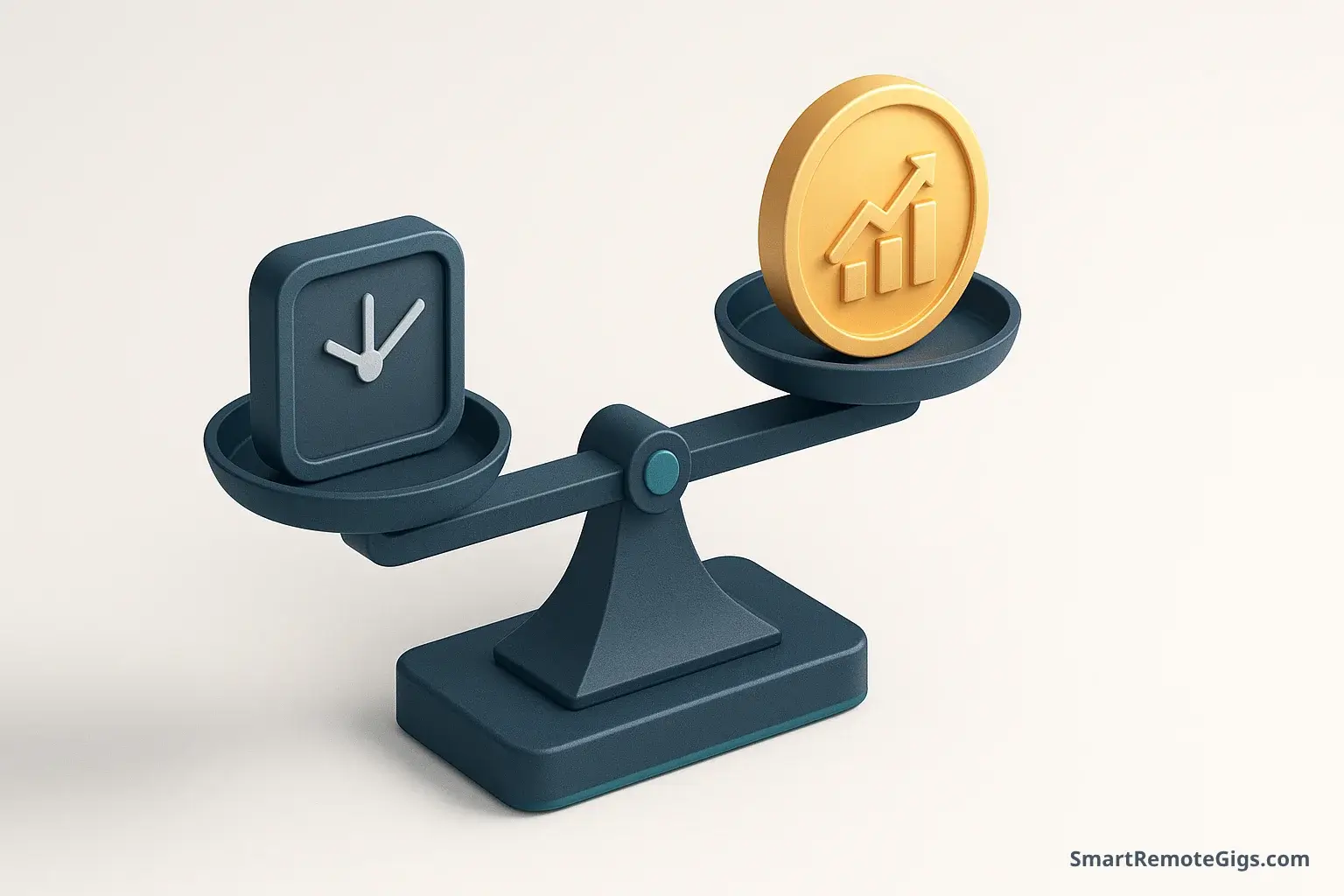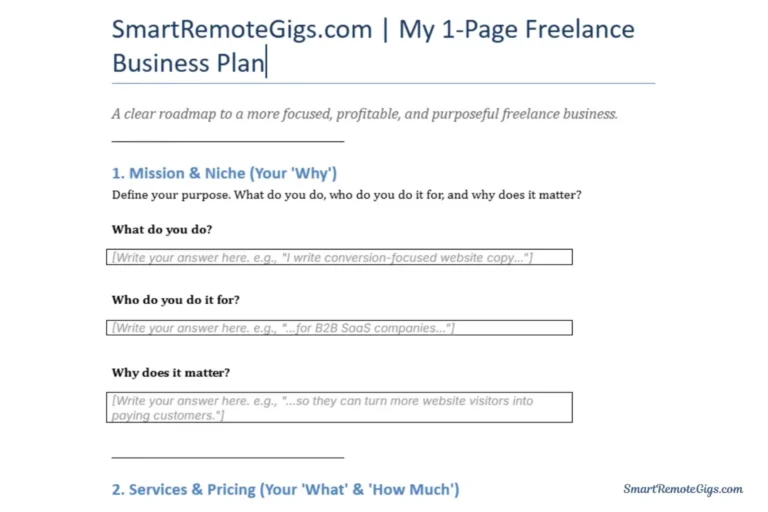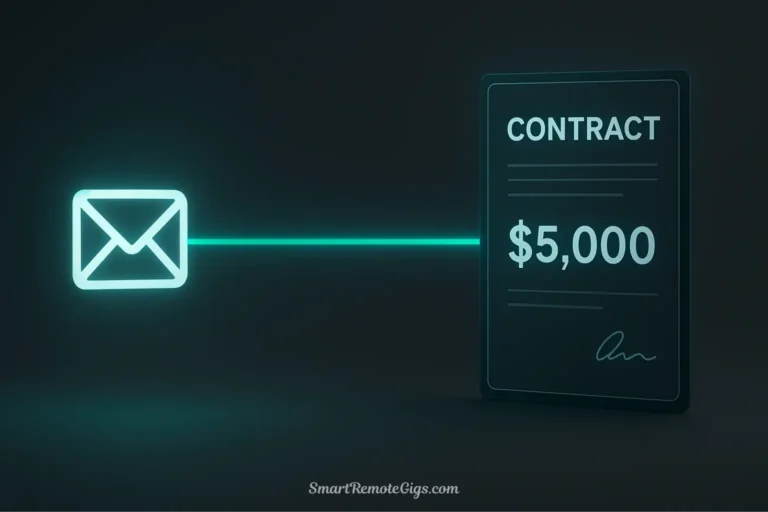Am I charging enough?
If you’re a freelancer, this question has probably kept you awake at night more than once. You’re not alone. Whether you’re just starting out or you’ve been freelancing for years, pricing your freelance services remains one of the most challenging aspects of running your own business.
Here’s the truth: setting the right freelance rates isn’t just about covering your expenses or matching what everyone else charges. It’s the single biggest lever you have for increasing your income and reducing burnout. Price too low, and you’ll find yourself working 60-hour weeks just to pay the bills. Price strategically, and you can work fewer hours while earning significantly more.
This isn’t another article filled with vague advice like “charge what you’re worth.” Instead, you’ll get a clear, actionable freelance pricing formula that takes the guesswork out of pricing. By the end, you’ll have a systematic approach that helps you price with confidence, attract better clients, and build a sustainable freelance business that creates the foundation for building passive income streams.
The Critical Mindset Shift: Stop Trading Hours for Money

Before we dive into specific pricing models, we need to address the fundamental flaw that keeps most freelancers trapped in a cycle of low rates and long hours: thinking of your time as the primary thing you’re selling.
When you price based purely on hours, you’re essentially punishing yourself for getting better at your job. The faster you work, the less you earn. The more efficient you become, the more your income suffers. This creates a perverse incentive to work slowly and inefficiently.
Consider two web developers: Sarah charges $50 per hour and takes 20 hours to build a website. She earns $1,000. Mike charges $100 per hour but only takes 8 hours to build the same quality website because he’s more experienced and efficient. He earns $800. Who would you rather be?
The answer seems obvious, but here’s the problem: Mike is still thinking in hourly terms. If Mike understood value-based pricing, he’d recognize that both websites provide the same value to the client—perhaps generating $10,000 in additional revenue annually. In that context, charging $2,500 for the project becomes entirely reasonable, regardless of whether it takes 8 hours or 80 hours.
This is the mindset shift that changes everything: you’re not selling hours. You’re selling outcomes, solutions, and results. Your price should reflect the value you create for your client, not the time it takes you to create it. This value-based pricing approach is also the foundation for creating productized services that can generate passive income.
3 Core Freelance Pricing Models (Pros & Cons)
Understanding your pricing options is crucial for making informed decisions about how to set freelance rates. Each model has its place, and the best freelancers often use different approaches for different types of projects and clients.
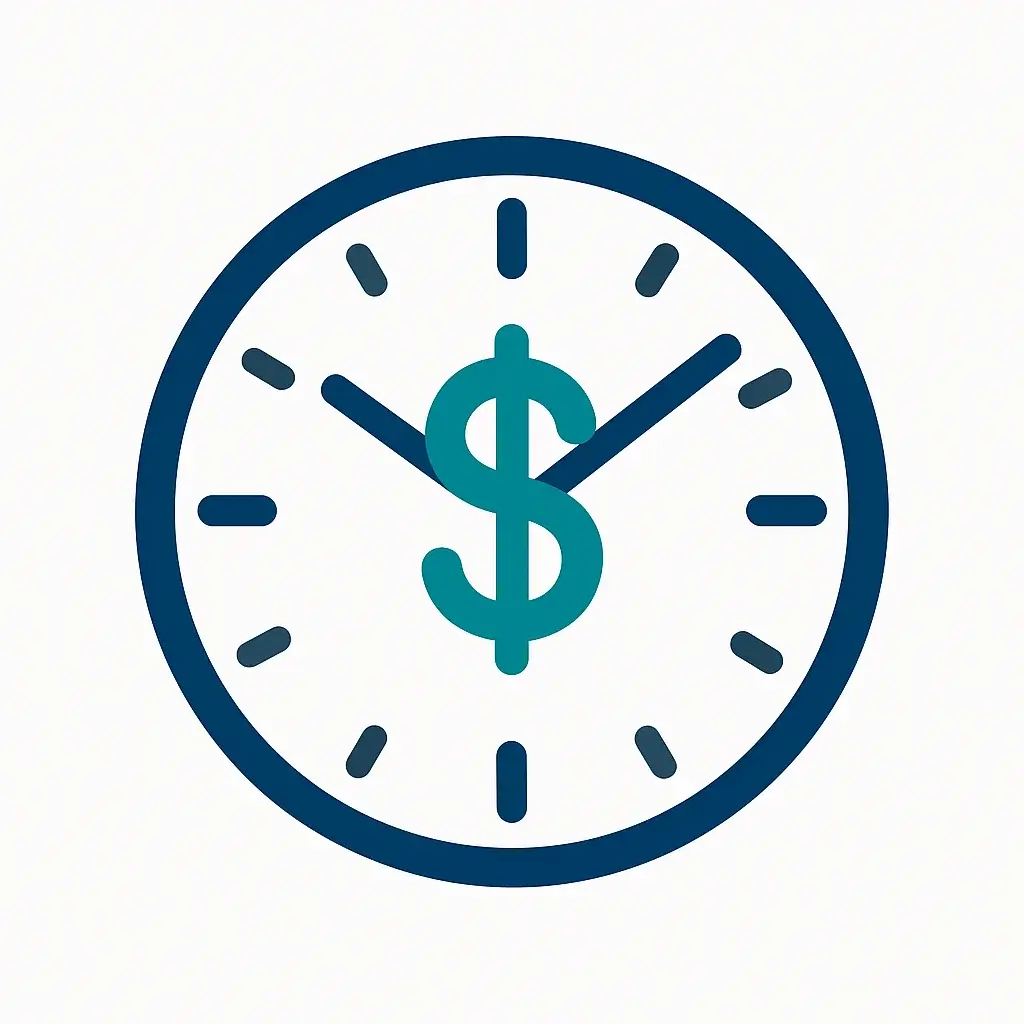
Model 1: Hourly Rate
What it is: You charge a fixed rate for each hour you work on a project. This is the most straightforward approach and often where new freelancers start.
Pros:
Cons:
Best for: New freelancers, projects with undefined scope, ongoing support work, or clients who specifically request hourly billing.

Model 2: Per-Project Fee
What it is: You charge a flat fee for delivering a specific outcome or set of deliverables, regardless of how long it takes.
Pros:
Cons:
Best for: Well-defined projects, experienced freelancers, clients focused on outcomes rather than process.
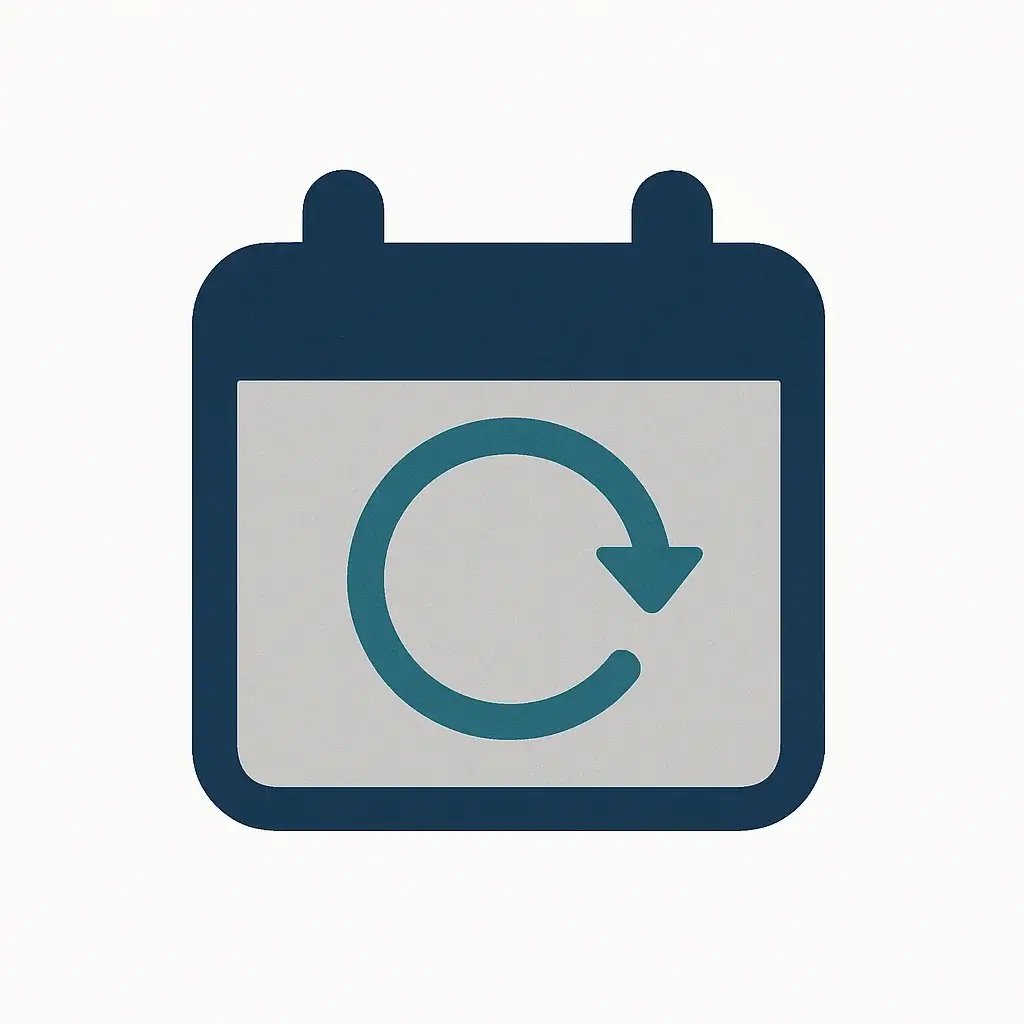
Model 3: The Retainer
What it is: A client pays you a fixed monthly fee in exchange for a predetermined amount of work or availability during that period.
Pros:
Cons:
Best for: Ongoing relationships, consultative work, maintenance projects, or when you want predictable income.
The Value-Based Pricing Formula: Our 4-Step Method
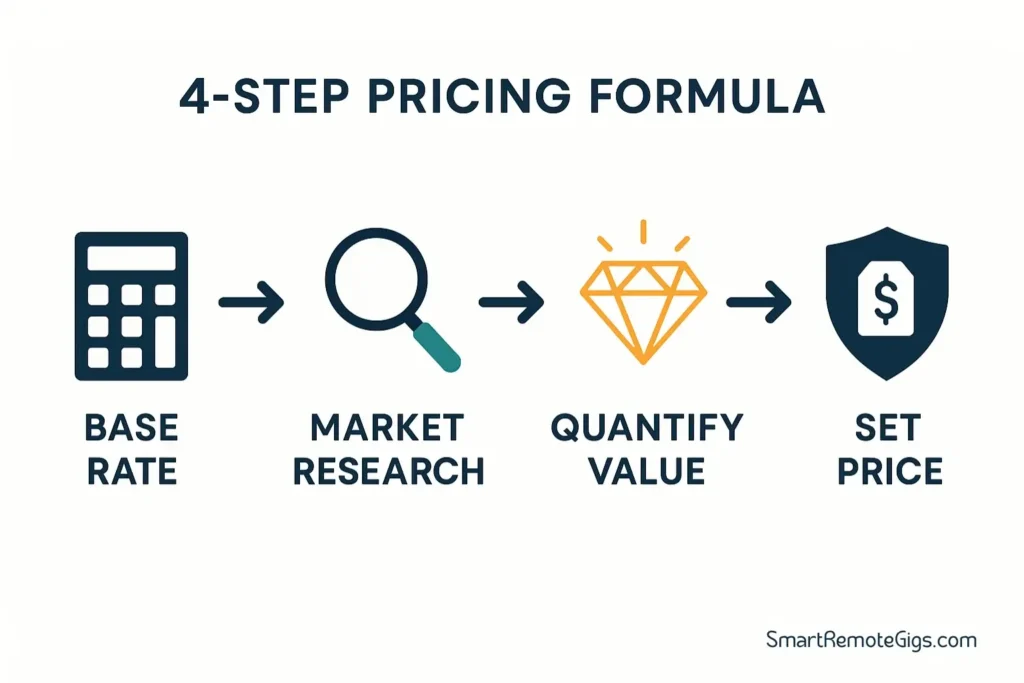
Now we get to the core of strategic pricing. This four-step freelance pricing guide combines practical financial planning with value assessment to help you price your freelance services confidently and profitably.
Step 1: Calculate Your Base Rate (Your “Survival Number”)
Your base rate isn’t what you should charge—it’s the absolute minimum you need to charge to keep your business running. Think of it as your financial foundation.
The Formula:
(Annual Personal Salary + Annual Business Expenses) ÷ Annual Billable Hours = Base Hourly Rate
Breaking it down:
Annual Personal Salary: What do you need to live comfortably? Include:
- Housing, utilities, food, transportation
- Healthcare and insurance premiums
- Retirement savings (aim for 10-15% of income)
- Emergency fund contributions
- Personal expenses and entertainment
Annual Business Expenses: What does it cost to run your freelance business?
- Professional software and tools
- Hardware and equipment
- Internet and phone bills
- Professional development and training
- Business insurance
- Accounting and legal fees (consider using QuickBooks or FreshBooks for expense tracking)
- Marketing and networking costs
- Office space (even if it’s part of your home)
- Taxes (remember, you pay both employer and employee portions of Social Security and Medicare)
Annual Billable Hours: This is not 40 hours × 52 weeks. Account for:
- Vacation time (2-4 weeks)
- Sick days
- Holidays
- Administrative time (invoicing, proposals, client communication)
- Business development time (networking, marketing, learning)
- Unbillable time between projects
A realistic estimate is 1,200-1,500 billable hours per year, not the 2,080 hours of a full-time employee.
Example Calculation:
- Personal salary needed: $60,000
- Business expenses: $15,000
- Total needed: $75,000
- Billable hours: 1,250
- Base rate: $75,000 ÷ 1,250 = $60/hour
This $60/hour is your survival number. Charging less than this means you’re slowly going out of business.
Step 2: Research the Market (Your “Reality Check”)
Your base rate tells you your minimum, but market research tells you what’s possible. You need both perspectives to price effectively.
Where to Research:
Professional Platforms:
- Upwork and Fiverr (but remember these skew toward the lower end)
- LinkedIn salary insights
- Glassdoor freelance rates
- Industry-specific job boards
Professional Communities:
- Industry Facebook groups and LinkedIn groups
- Local professional meetups
- Professional associations in your field
- Online forums like Reddit’s freelance communities
Direct Networking:
- Conversations with other freelancers (many are surprisingly open about rates)
- Client feedback about previous vendors
- Industry conferences and workshops
What to Look For:
- Rate ranges for your skill level and experience
- How rates vary by project type and client size
- Geographic differences (remote work has changed this significantly)
- Premium pricing for specialized skills
Research Tips:
- Don’t just look at the lowest rates—these often represent desperate pricing
- Pay attention to what successful freelancers charge, not just beginners
- Consider the full package: some lower rates come with additional benefits
- Remember that posted rates and actual paid rates can differ significantly
Step 3: Quantify Your Value (The “Impact Multiplier”)
This is where most freelancers stumble, but it’s also where the biggest opportunities lie. Instead of thinking about what your work costs, think about what your work is worth to the client.
Key Questions to Ask:
Revenue Generation:
- How much revenue will this project generate for the client?
- Will it help them launch a new product or service?
- Does it improve their conversion rates or sales processes?
- Will it help them enter new markets?
Cost Savings:
- How much money will this project save the client?
- Does it automate manual processes?
- Will it reduce their need for other vendors or employees?
- Does it prevent costly mistakes or legal issues?
Strategic Value:
- How does this project support their core business objectives?
- Does it give them a competitive advantage?
- Will it improve their brand reputation or customer satisfaction?
- Does it position them for future growth or opportunities?
Time Value:
- How much time will this save the client or their team?
- What could they do with that recovered time?
- How quickly do they need this completed?
- What’s the cost of delaying this project?
Example Value Assessment: You’re designing a landing page for a client’s new product launch. Instead of thinking “this is 20 hours of design work,” consider:
- The product launch represents $500,000 in projected first-year revenue
- A well-designed landing page could improve conversion rates by 2-3%
- That improvement could mean an additional $10,000-$15,000 in revenue
- The client’s previous designer charged $800 and delivered poor results
- Your design expertise could mean the difference between launch success and failure
In this context, charging $3,000-$5,000 for the landing page becomes entirely reasonable, even if it only takes you 15 hours to complete.
Step 4: Set Your Price with Confidence
Now you combine your base rate, market research, and value assessment to create a confident pricing strategy.
The Confidence Formula:
Final Price = MAX(Base Rate × Hours, Market Rate for Similar Projects, Value-Based Price)
Pricing Psychology Tips:
Anchor High: Present your premium option first. When clients see a $5,000 proposal before a $3,000 one, the latter feels like a bargain.
Offer Options: Present 2-3 pricing tiers. Most clients choose the middle option, but having a premium tier makes your standard offering look reasonable.
Bundle Value: Don’t just list your price—list everything included. “Website design: $3,000” feels expensive. “Complete website package including custom design, mobile optimization, SEO setup, content management system, two rounds of revisions, and 30 days of support: $3,000” feels like value.
Payment Terms: Consider offering a small discount for full upfront payment, or structure payments to improve your cash flow (50% to start, 50% on completion). Tools like Harvest or FreshBooks can help you manage invoicing and payment tracking efficiently.
Example Pricing Structure:
- Essential Package: $2,500 – Basic website with standard features
- Professional Package: $4,000 – Enhanced design plus SEO optimization and analytics setup
- Premium Package: $6,500 – Everything above plus e-commerce integration and monthly maintenance
Don’t Forget These: 4 Common Pricing Mistakes to Avoid
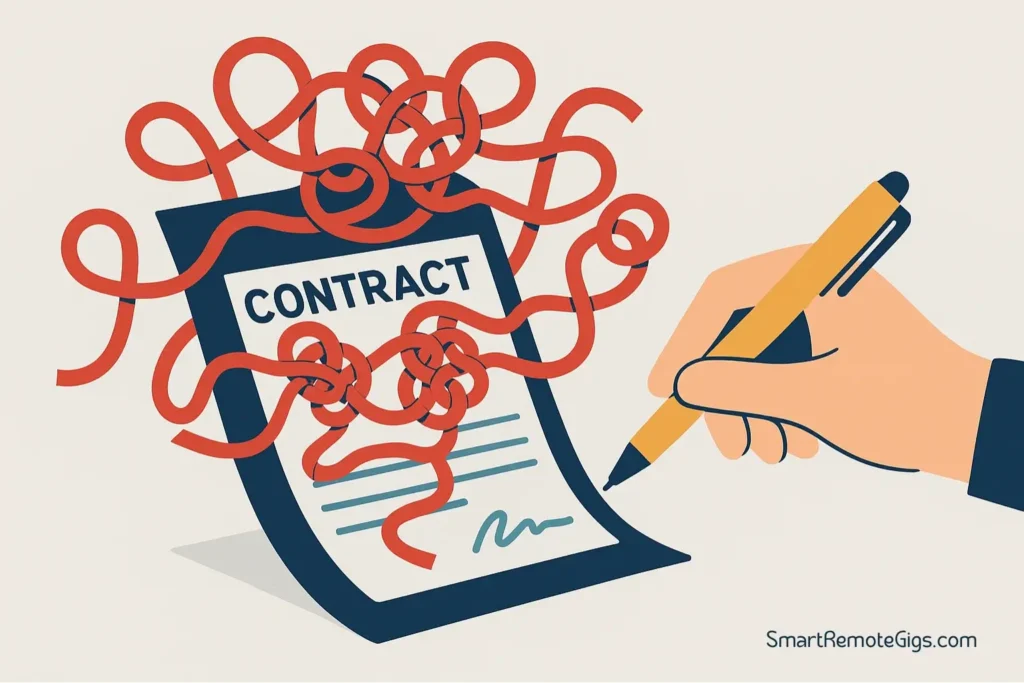
Even with a solid freelance pricing strategy, these common mistakes can undermine your profitability and professional reputation.
1. Ignoring Scope Creep (and how to prevent it with a clear contract)
The Problem: Client requests keep expanding beyond the original agreement, turning your profitable project into a money-losing nightmare.
The Solution:
- Define deliverables in specific, measurable terms
- Include a clause for additional work: “Changes beyond the agreed scope will be billed at $X per hour”
- Set limits on revisions: “Includes two rounds of revisions; additional revisions billed separately”
- Document everything: when scope changes are requested, send a written confirmation with cost implications
- Use project management tools that make scope changes visible to both parties
Contract Language Example: “This proposal includes [specific deliverables]. Any additional features, pages, or functionality requested after project approval will be considered outside the project scope and will be quoted separately before work begins.”
2. Not Charging for “Admin” Time (communication, revisions)
The Problem: You quote based on “hands-on” work time but don’t account for client communication, project management, revisions, and administrative tasks.
The Reality Check: For every hour of actual design, writing, or development work, you typically spend 20-30 minutes on:
- Client emails and calls
- Project status updates
- File organization and backups
- Revisions and feedback incorporation
- Invoice preparation and follow-up
The Solution:
- Build administrative time into your project estimates
- Charge for excessive communication: “Includes up to 2 hours of consultation calls; additional calls billed at hourly rate”
- Set boundaries on communication methods and frequency
- Use time-tracking tools to understand your true time investment
3. Giving “Friend” Discounts (and what to do instead)
The Problem: You offer discounts to friends, family, or “good cause” projects, training clients to expect lower rates and devaluing your work.
The Hidden Costs:
- Friends often have the highest expectations and lowest patience
- Discounted work still requires full effort but provides partial compensation
- Other clients may hear about your “friend rates” and request similar pricing
- You may resent the relationship when the project becomes difficult
Better Alternatives:
- Pro bono with boundaries: Offer completely free work for causes you believe in, but set clear limits
- Referral rewards: Give friends a referral fee for bringing you paying clients instead of discounting your work
- Payment plans: Offer extended payment terms instead of reduced rates
- Skill exchanges: Trade services with other professionals instead of discounting
What to Say: “I’d love to help you with this project. My standard rate for this type of work is $X. If budget is a concern, I can suggest some ways to scope the project to fit your needs, or we could discuss a payment plan.”
4. Displaying a Single, Low Price on Your Website
The Problem: Listing one low price on your website attracts bargain hunters and makes it difficult to sell higher-value services.
Why This Backfires:
- Serious clients may assume low prices mean low quality
- You can’t easily raise rates with clients who found you through posted prices
- It commoditizes your services instead of positioning you as a consultant
- You lose the opportunity to customize pricing based on client needs and budget
Better Approaches:
- “Starting at” pricing: “Website design starting at $2,500”
- Package options: Present multiple tiers without specific pricing
- Custom pricing: “Pricing customized based on your specific needs”
- Value-based copy: Focus on outcomes and benefits rather than features and prices
Website Copy Example: Instead of: “Logo design: $500” Try: “Complete brand identity packages starting at $1,500. Each project is customized based on your industry, target audience, and business goals. Contact us for a personalized quote.”
FAQ: Your Freelance Pricing Questions Answered
How do I raise my rates with existing clients?
The gradual approach:
Raise rates only on new projects, not mid-project
Give 30-60 days notice before rate increases take effect
Increase by 10-20% annually rather than making large jumps
Explain the increase in terms of value, not personal needs
Sample Communication: “I wanted to give you advance notice that my rates will be increasing to $X starting [date]. This reflects my expanded expertise and the additional value I’ve been bringing to your projects. I’m committed to continuing to deliver excellent results for your business.”
The positioning approach:
Introduce new “premium” services at higher rates
Gradually transition existing clients to premium packages
Let them see the value difference before discussing price
Should I put my prices on my website?
Consider posting prices if:
You offer standardized packages
You want to filter out clients with smaller budgets
Your target market shops primarily on price
You have a high volume of small projects
Avoid posting prices if:
Your work is highly customized
You target enterprise or high-value clients
You want to sell value before discussing price
Your prices vary significantly based on scope
The middle ground:
Post starting prices or price ranges
Offer downloadable pricing guides in exchange for email addresses
Use “pricing calculators” that customize based on client needs
What’s the difference between a quote, an estimate, and a proposal?
Estimate: A rough approximation of cost, usually provided quickly and informally. Not legally binding. Use when clients are in early planning stages.
Quote: A fixed price that you’ll honor for a specific period (usually 30 days). More detailed than an estimate. Becomes binding when client accepts.
Proposal: A comprehensive document that includes project scope, timeline, deliverables, terms, and pricing. Often used for larger projects. May include multiple pricing options.
When to use each:
Estimate: “Can you give me a ballpark for a logo design?” Response: “$500-$1,500 depending on complexity”
Quote: “What would you charge for a 5-page website?” Response: Detailed breakdown totaling $3,200
Proposal: Major project requiring detailed planning, multiple stakeholders, or custom approach
Conclusion: Your Next Step Toward Profitable Freelancing

Value-based pricing isn’t just about charging more money—it’s about positioning yourself as a strategic partner rather than a commodity service provider. When you price based on the value you create, you attract better clients, work on more interesting projects, and build a sustainable business that doesn’t require you to work 80-hour weeks.
The freelance pricing formula we’ve covered gives you a systematic approach to pricing, but remember that confidence comes from practice. Start by calculating your base rate today. Research what others in your field are charging. For your next project, spend time understanding the client’s business challenges and the value your solution provides.
Most importantly, remember that your expertise has value. The skills you’ve developed, the problems you can solve, and the results you can deliver are worth investing in. Price accordingly.
Once you’ve mastered profitable pricing, you’ll be ready to take the next step: creating passive income streams through productized services and scalable business models. Profitable pricing is the foundation that makes everything else possible.
Your next proposal is your chance to stop being a service provider and start being a strategic partner. Use these tools, trust your expertise, and price with confidence. Your business—and your bank account—will thank you.

